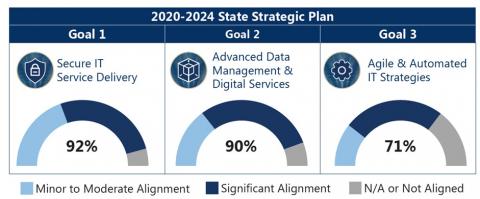Shaping Texas' technology present and future
Each day, technology grows more central to the operation of government in Texas. IT offers state agencies, local governments, and schools the opportunity to do more with less. But as with all technology, challenges and questions regularly arise. Our job at DIR is to address those challenges and answer those questions so our government entities can remain focused on their missions.
What do the laws say about technology?
The “Information Resources Management Act” describes “information technology” as inherently valuable because it’s paid for by the residents of Texas.
Planning and Policy Efforts
State Agency Alignment with State Technology Goals
State agencies show alignment with fundamental areas of technology for security and data management, while alignment with emerging technologies is evolving.

How DIR Shapes Statewide IT Policy
Reporting is a big part of our work. For starters, every agency at the state level must report on their technology to DIR. These reports help shape the “State Strategic Plan for Information Resources Management”—a plan we issue every other year that lists technology priorities and a five-year plan for addressing them.
On even-number years, DIR provides the Texas Legislature with the “Biennial Performance Report on the Use of Information Resources Technology,” which details how our state agencies are fulfilling the state’s technology priorities and how legislators can help. We also track technology-related legislation during every legislative session, including those informed by our recommendations.
Finally, we offer each state agency’s Information Resource Manager with the tools and resources they need to collaborate with and report to DIR.
About File Formats
Some documents on this page are in the PDF format. Please download the Adobe Reader in order to view these documents.